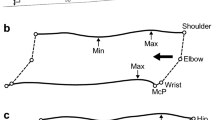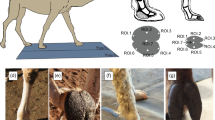Abstract
The primate hand adopts a variety of postures during locomotion. Habitually terrestrial cercopithecine primates are known to use a palmigrade posture at faster speeds to possibly mitigate stresses on the hand skeleton; however, it is unclear whether arboreal or semi-terrestrial species use a similar strategy for adjusting hand posture. Here, we explored intra-individual variation in hand contact patterns during terrestrial locomotion in the Japanese macaque (Macaca fuscata), a semi-terrestrial cercopithecine primate. Two monkeys were required to walk on the ground at their own preferred speeds or were encouraged to move faster for food rewards. The contact area under the hand and ground reaction forces (GRFs) were measured simultaneously using a tactile pressure sensor, and then hand pressures were calculated offline. We found that hand contact patterns could vary within individuals. The monkeys used predominantly a palmigrade posture within the range of speeds covered in this study (0.72–2.56 m s−1). There were two subtypes of palmigrade posture. In one subtype, the hypothenar pad did not contact the substrate, whereas the entire hand contacted the substrate in the other. The palm of the palmigrade hand with total-hand contact experienced similar or lower peak pressure and pressure–time integral than those of the palmigrade hand without hypothenar pad contact even though it experienced higher peak GRFs. The moderate peak pressure experienced by the palmigrade hand with total-hand contact was due to increased contact area under the palm. The total contact area of the fingers and peak GRF to the fingers were relatively unchanged with different patterns of hand contact. These findings provide evidence that when walking on the ground, semi-terrestrial Japanese macaques use a palmigrade posture with total-hand contact to attenuate stresses on hand bones, as do habitually terrestrial species.






Similar content being viewed by others
References
Bishop A (1964) Use of the hand in lower primates. In: Buettner-Janusch J (ed) Evolutionary and genetic biology of primates, vol 2. Academic, New York, pp 133–225
Chadwell BA, Young JW (2015) Angular momentum and arboreal stability in common marmosets (Callithrix jacchus). Am J Phys Anthropol 156:565–576
D’Août K, Vereecke E, Schoonaert K, De Clercq D, Van Elsacker L, Aerts P (2004) Locomotion in bonobos (Pan paniscus): differences and similarities between bipedal and quadrupedal terrestrial walking, and a comparison with other locomotor modes. J Anat 204:353–361
Demes B, Larson SG, Stern JT, Jungers WL, Biknevicius AR, Schmitt D (1994) The kinetics of primate quadrupedalism: “hindlimb drive” reconsidered. J Hum Evol 26:353–374
Etter HF (1973) Terrestrial adaptations in the hands of Cercopithecinae. Folia Primatol 20:331–350
Fleagle JG (2013) Primate adaptation and evolution, 3rd edn. Academic, San Diego
Hayama S, Chatani K, Nakatsukasa M (1994) The digitigrade hand and terrestrial adaptation in Japanese macaques. Anthropol Sci 102(Suppl):115–125
Higurashi Y, Hirasaki E, Kumakura H (2009) Gaits of Japanese macaques (Macaca fuscata) on a horizontal ladder and arboreal stability. Am J Phys Anthropol 138:448–457
Hildebrand M (1967) Symmetrical gaits of primates. Am J Phys Anthropol 26:119–130
Kimura T (1985) Bipedal and quadrupedal walking of primates: comparative dynamics. In: Kondo S (ed) Primate morphophysiology, locomotor analyses and human bipedalism. University of Tokyo Press, Tokyo, pp 81–104
Larson SG, Stern JT Jr (1987) EMG of chimpanzee shoulder muscles during knuckle-walking: problems of terrestrial locomotion in a suspensory adapted primate. J Zool 212:629–655
Mori S, Miyashita E, Nakajima K, Asanome M (1996) Quadrupedal locomotor movements in monkeys (M. Fuscata) on a treadmill: kinematic analyses. NeuroReport 7:2277–2285
Nakagawa N, Nakamichi M, Sugiura H (eds) (2010) The Japanese macaques. Springer, Tokyo
Nakano Y (1996) Footfall patterns in the early development of the quadrupedal walking of Japanese macaques. Folia Primatol 66:113–125
Patel BA (2009) Not so fast: speed effects on forelimb kinematics in cercopithecine monkeys and implications for digitigrade postures in primates. Am J Phys Anthropol 140:92–112
Patel BA (2010a) Functional morphology of cercopithecoid primate metacarpals. J Hum Evol 58:320–337
Patel BA (2010b) The interplay between speed, kinetics, and hand postures during primate terrestrial locomotion. Am J Phys Anthropol 141:222–234
Patel BA, Polk JD (2010) Distal forelimb kinematics in Erythrocebus patas and Papio anubis during walking and galloping. Int J Primatol 31:191–207
Patel BA, Wunderlich RE (2010) Dynamic pressure patterns in the hands of olive baboons (Papio anubis) during terrestrial locomotion: implications for cercopithecoid primate hand morphology. Anat Rec (Hoboken) 293:710–718
Rawlins RG (1993) Locomotive and manipulative use of the hand in the Cayo Santiago macaques (Macaca mulatta). In: Preuschoft H, Chivers DJ (eds) Hands of Primates. Springer, Wien, pp 21–30
Schmitt D (2010) Primate locomotor evolution: biomechanical studies of primate locomotion and their implications for understanding primate neuroethology. In: Platt ML, Ghazanfar AA (eds) primate neuroethology. Oxford University Press, New York, pp 31–60
Zeininger A, Shapiro LJ, Raichlen DA (2017) Ontogenetic changes in limb postures and their impact on effective limb length in baboons (Papio cynocephalus). Am J Phys Anthropol 163:231–241
Acknowledgements
We are indebted to Dr. Kazunori Yamada, Associate Professor in the Ethological Studies Laboratory in the Graduate School of Human Sciences at Osaka University, for providing the video footage of free-ranging Japanese macaques running at high speeds. We are grateful to Dr. Katsumi Nakajima, Lecturer in the Department of Physiology at Kindai University Faculty of Medicine, and two anonymous reviewers for comments on the manuscript.
Author information
Authors and Affiliations
Corresponding author
About this article
Cite this article
Higurashi, Y., Goto, R. & Kumakura, H. Intra-individual variation in hand postures during terrestrial locomotion in Japanese macaques (Macaca fuscata). Primates 59, 61–68 (2018). https://doi.org/10.1007/s10329-017-0619-6
Received:
Accepted:
Published:
Issue Date:
DOI: https://doi.org/10.1007/s10329-017-0619-6




